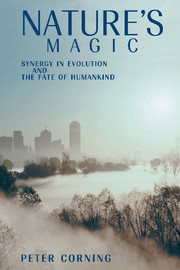Book contents
- Frontmatter
- Contents
- 1 Prologue: The New Evolutionary Paradigm
- 2 The “Enchanted Loom”
- 3 The Magic Castle
- 4 “Black Magic”
- 5 The Synergism Hypothesis
- 6 “The Sorcerer's Apprentice”
- 7 Conjuring Human Evolution: The Synergistic Ape
- 8 Conjuring History: Does Cultural Evolution Have an “Arrow”?
- 9 The Science of History
- 10 Conjuring the Future: What Can We Predict?
- Afterword
- Notes
- References
- Index
7 - Conjuring Human Evolution: The Synergistic Ape
Published online by Cambridge University Press: 22 August 2009
- Frontmatter
- Contents
- 1 Prologue: The New Evolutionary Paradigm
- 2 The “Enchanted Loom”
- 3 The Magic Castle
- 4 “Black Magic”
- 5 The Synergism Hypothesis
- 6 “The Sorcerer's Apprentice”
- 7 Conjuring Human Evolution: The Synergistic Ape
- 8 Conjuring History: Does Cultural Evolution Have an “Arrow”?
- 9 The Science of History
- 10 Conjuring the Future: What Can We Predict?
- Afterword
- Notes
- References
- Index
Summary
There are many fearful and wonderful things,
but none is more fearful and wonderful than man.
He makes his path over the storm-swept sea
and he harries old Earth with his plough.
He takes the wild beasts captive and turns them into his servants.
He has taught himself speech and wind-swift thought,
and the habits that pertain to government.
Against everything that confronts him he invents some resource – against death alone he has no resource.
Sophocles AntigoneLet's begin with a parable. It is early morning on the East African savanna, and a troop of sleeping baboons begins to stir. The troop has been sequestered overnight at a nesting site (the jagged face of an ancient rift) that is well protected from various carnivore enemies. But now the troop - comprising about 30 males, females, juveniles, and infants – is getting ready to split into smaller “clans” (or sometimes larger “bands”) and set off together on their daily food quest. (It's dangerous for baboons to travel alone in open country.) Each clan/band will cover several miles, before returning by nightfall to the safety of its sleeping site.
The leader of one of these groups is a large, confident alpha male that has earned his job the old-fashioned way. He bears a number of battle scars from the formidable canines of his rivals, not to mention some violent conflicts with rival troops.
- Type
- Chapter
- Information
- Nature's MagicSynergy in Evolution and the Fate of Humankind, pp. 188 - 239Publisher: Cambridge University PressPrint publication year: 2003



